Laptop Mag Verdict
The XPS 13 2-in-1 combines portability, comfort and plenty of power in a sleek, fanless design, but we wish the battery lasted longer.
Pros
- +
Most compact 2-in-1 with 13-inch screen
- +
Comfortable keyboard
- +
Vibrant InfinityEdge display
- +
Impressive audio
- +
Dynamic Power Mode boosts speed when you need it
Cons
- -
Battery life isn't as long as on other 2-in-1s
- -
Camera is still beneath the display
- -
Intel Core U machines are faster
Why you can trust Laptop Mag
The regular XPS 13 has been our favorite consumer laptop for more than two years, because of its luxuriously lightweight chassis, gorgeous InfinityEdge display and long battery life. Now, Dell has taken all the slim carbon fiber-goodness from its flagship ultrabook and applied it to a brand new hybrid, which goes on sale Jan. 5 on Dell.com and at Best Buy online.
Available for a starting price of $999, the XPS 13 2-in-1 isn't just a refresh of its clamshell brother; it's a machine with a distinct design and features that make it a mostly satisfying convertible. The chassis is thinner than the one on the XPS 13 clamshell, which makes it easier to use as a tablet. And this is a totally fanless affair, so you can curl up with an episode of Black Mirror and not have to worry about getting distracted by noise.
Plus, for the first time, Dell is introducing its new Dynamic Power Mode technology on a laptop, which scales up the clock speed when you need more performance. And that's important, given that this system uses an Intel Y Series Kaby Lake processor (formerly known as Core M), instead of the typically more robust U Series. You do get fewer ports than on the regular XPS 13, and the battery life could be longer, but overall, the XPS 13 2-in-1 is one of the best Surface Pro alternatives.
Design: Luxuriously svelte
From across the room, you could be forgiven for mistaking the XPS 13 2-in-1 for the regular model. And that's a good thing. You still get a sturdy machined-aluminum cover and bottom with a soft, carbon-fiber deck on the inside, which not only stays cool to the touch but makes typing comfy. But Dell added two steel hinges wrapped in aluminum while slimming down the design. I do wish the lid were easier to open, though; there's no lip on the front.
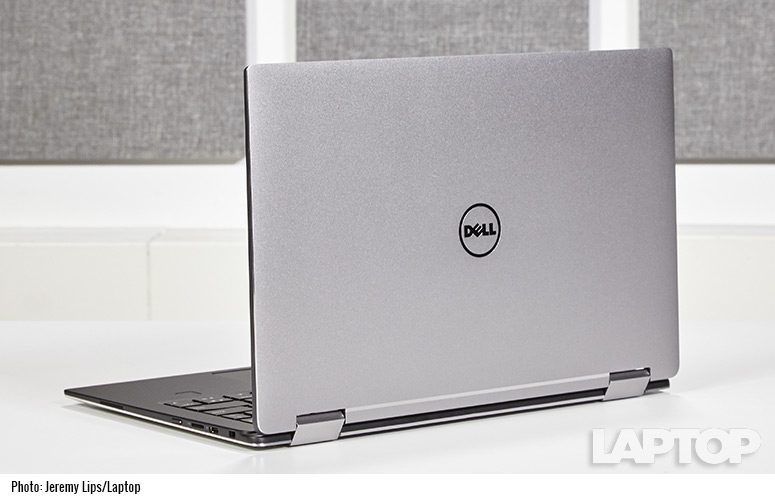
This 2-in-1 measures just 0.32 to 0.54 inches thick, compared to 0.33 to 0.6 inches for the more traditional XPS 13. I appreciated the difference on a tabletop, and even more when I held both systems. The reduced thickness comes in handy when you're using the XPS 13 2-in-1 in tablet mode. In comparison, the Lenovo Yoga 910 is 0.56 inches thick and the HP Spectre x360 is 0.54 inches thick, but the Acer Spin's thickness is only 0.4 inches.
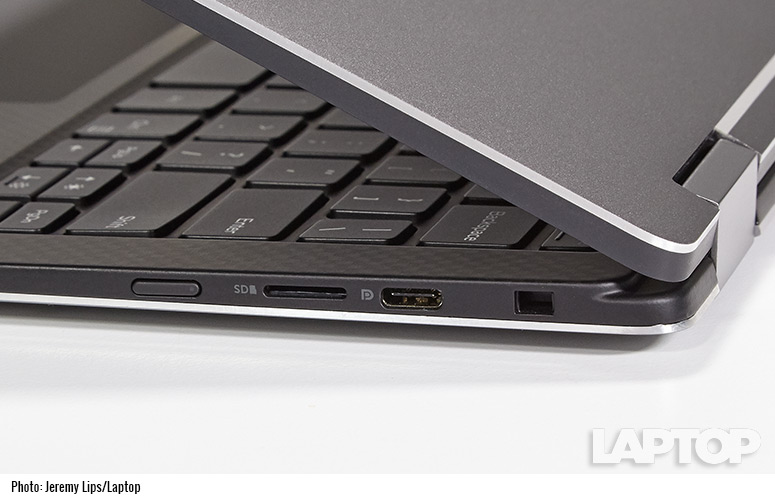
The XPS 13 2-in-1 is quite light, weighing 2.7 pounds. That's less than the touch version of the regular XPS 13 (2.9 pounds) and lighter than the HP Spectre x360 (2.8 pounds) and the Lenovo Yoga 910 (3.04 pounds). The biggest difference between this convertible XPS 13 and the HP and Lenovo models is how much smaller its footprint is from front to back. Those extra couple of inches made a big difference during my bus commute home, as I didn't have to worry about the person sitting in front of me reclining too far.
To get this 2-in-1 so thin and light, Dell had to make some trade-offs. You won't find a full-size USB port or an SD card slot, but you will find a Thunderbolt 3 port, a USB Type-C port and a microSD card slot. Fortunately, Dell is also including a USB-C to USB-A adapter, which will make it easier to connect phones and other devices; Apple doesn't do that with its MacBook or MacBook Pro.
For now, the XPS 13 2-in-1 is available in silver, but I'm hoping for a rose-gold option and other colors soon.
Display: Gorgeous picture, multiple modes
If you like captivating images, the XPS 13 2-in-1 will not disappoint you. This convertible's InfinityEdge display has barely-there bezels that measure just 0.2 inches, making it seem as though the panel were floating above the keyboard. It also allows Dell to cram a 13-inch, full-HD screen into a design that's as compact as an 11-inch laptop.

The standard 1920 x 1080 touch screen was plenty sharp and colorful for my taste. A quad-HD (3200 x 1800) screen is also available.
When watching the trailer for Logan on this 2-in-1, I could see every scar on Wolverine's battle-worn back, and a toppled, rusted water tower resting on sand was a somber mix of orange, red and brown.
In our lab tests, the XPS 13 2-in-1's panel reproduced an impressive 107.2 percent of the sRGB color gamut. The Acer Spin 7 and the HP Spectre x360 scored a bit lower, at 102 percent and 101.7 percent, respectively, while the Lenovo Yoga 910's screen mustered 98 percent. I do wish the colors were more accurate, however; the XPS 13 2-in-1's panel notched a Delta-E score of 6.08, which is much higher than the ideal score of 0.
The screen on Dell's convertible is pretty bright: It registered 314 nits, which is in between the Lenovo and the HP.
Thanks to its hinged design, the XPS 13 2-in-1 supports multiple modes, including laptop, tablet, tent and stand. I really appreciated being able to binge watch Netflix with the InfinityEdge screen in stand mode while I did stuff around the house.
Keyboard and Touchpad: Comfy and responsive
On this hybrid, Dell maintained the 1.3 millimeters of key travel from the regular XPS 13. The result is a cushy typing experience, especially compared to the feel of my MacBook's flat layout. I typed quickly and accurately as I wrote this review, and I easily reached 71 words per minute on the 10fastfingers.com typing test, which is slightly above my 65- to 70-wpm average.

The XPS 13 2-in-1 also incorporates some layout changes based on user feedback. The Home and End keys now have dedicated keys in the top-right corner, and there are also dedicated PgUp and PgDown keys. All four of these keys were formerly integrated into the arrow buttons as function keys.
Dell's Precision Touchpad mostly lived up to its name in my testing. I executed gestures with ease, such as sliding three fingers up to show open apps, and pinching to zoom (although the Edge browser was much smoother than Chrome). I had no problems navigating the desktop and selecting text. But sometimes, on the first unit we tested, the cursor wouldn't move right away. A second unit didn't exhibit this issue.
Optional Active Pen: Works well, but no holster
If you want to take full advantage of the inking features in Windows 10 and the ability to sketch and draw, you can buy Dell's $49 Active Pen PN556W and use it with the XPS 13 2-in-1.
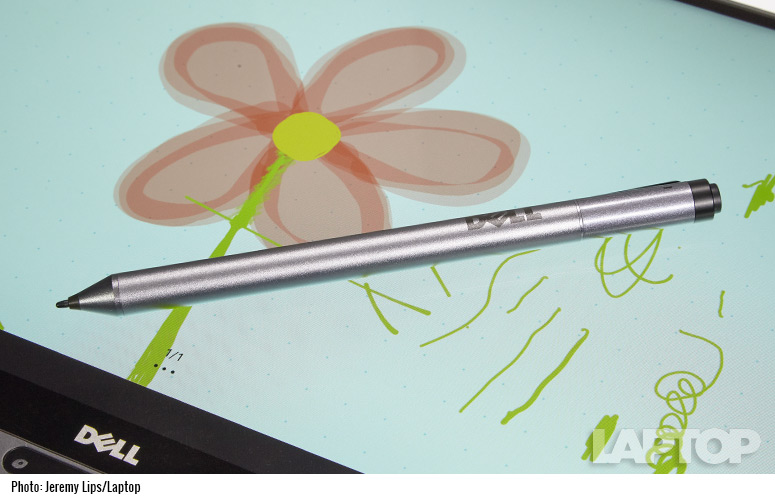
It provides 2,048 levels of sensitivity, and there's built-in palm rejection so your hand won't make any accidental marks on your digital canvas. The stylus, which has been on the market for a year and works with other laptops, also has a rear button that can launch the Windows Start menu, Windows Ink or any other apps you choose with a single or double click.
MORE: The Best Pen for Your Tablet
Drawing with the PN556W felt extremely natural, with feedback that was similar to pressing a ballpoint pen onto paper. As I sketched in the Bamboo Paper app, lines appeared thicker the harder I pushed the tip of the pen against the screen.
Unfortunately, there's no place to put this pen when it's not in use, so you'll have to carry it separately. It would have been nice to attach it magnetically to the side of the screen.
Audio: Solid
The XPS 13 2-in-1 packs a sonic punch for such a compact system. When I played George Michael's "Freedom! '90" through the two 1-watt speakers (under the keyboard), his defiant vocals sounded clear even at max volume, and every high-hat hit was crisp. I liked that I could tweak the bass, detail and width via the Waves MaxxAudio Pro app.
Fingerprint Reader and Webcam: Facial recognition later
I'm not a fan of entering passwords to log in to my system, so I'm glad that Dell added a fingerprint reader to the XPS 13 2-in-1. After the initial setup, which took just a little over a minute, I could log in via Windows Hello just by placing my finger on the sensor -- no swiping required.
It took a bit longer to log in from a cold boot than I'd like (a few seconds), but logging in when resuming from sleep was almost instant. I also could use the fingerprint reader to purchase and download items in the Windows Store.
Eventually, you'll be able to just stare at this convertible to log in, because there's an infrared camera next to the regular webcam. However, Dell says this feature won't be enabled until a future update of Windows 10. So it's vestigial for now.
The bad news is that the regular 720p webcam is still underneath the display, which results in unflattering shots of your chin during Skype calls. The good news is that it's now centered instead of being off to the left.
Plus, if you flip the display around and place the system in tent mode, you can video chat with the camera on top, though you'll lose access to the keyboard. I generally found that the images I captured were fuzzy, though the colors in my checkered shirt looked accurate.
Performance: Boost when you need it, but not the best
Don't dismiss the XPS 13 2-in-1 as a slow poke, because it has an Intel Y Series processor (formerly known as Core M). Dell found a way to scale up the performance on the fly while keeping the temperatures fairly cool. Using a new feature that Dell developed, called Dynamic Power Mode, this system can deliver short bursts of power. It's not as fast as the U Series chips found inside other convertibles, but overall, this Dell was snappier than we were expecting. You can learn more about how Dell implemented its Dynamic Power Mode in our making of the XPS 13 2-in-1 article.
We tested a configuration with a 1.2-GHz Core i5-7Y54 processor, 8GB of RAM and a 256GB PCIe solid-state drive. During my testing, I used the XPS 13 2-in-1 as my everyday machine for more than a week, and it ably handled my typical workload, which includes bouncing between Chrome with more than a dozen tabs open, managing multiple conversations in HipChat and streaming tunes on Spotify.
On Geekbench 4, which measures overall performance, the Dell scored 6,498. That's better than the Acer Spin 7's mark of 5,777 (1.3-GHz Intel Core i7-7Y75 mobile CPU, 8GB of RAM, 256GB SSD) and the latest 12-inch MacBook's 5,258 (1.2-GHz Core m5, 8GB of RAM, 256GB SSD). However, two 2-in-1s with a higher-power Core i7 U Series chip -- the HP Spectre x360 and the Lenovo Yoga 910 -- surpassed 8,000.
It took the Dell 4 minutes and 14 seconds to match 20,000 names and addresses in OpenOffice, which is faster than the Acer's 4:36 but nowhere near as quick as the MacBook's 3:11, the HP's 3:34 or the Lenovo's 3:33.
The Dell's PCIe SSD averaged a transfer rate of 187 MBps, which beats the ultraportable category average (176.9 MBps) and the Acer Spin 7 (124.1 MBps). But again, the Yoga 910 and the Spectre x360 turned in speedier scores of 195.7 MBps and 318.1 MBps, respectively.
Don't expect to play anything other than casual games on this machine. The XPS 13 2-in-1 couldn't muster playable frame rates on the Dirt 3 game, averaging 21.2 frames per second. The Acer Spin 7 mustered 32 fps, while the Spectre x360 (40 fps) and the Yoga 910 (50 fps) scored considerably higher.
Battery Life: Above average
Dell packed a 46-watt-hour battery inside the XPS 13 2-in-1, which is significantly smaller than the 60-watt-hour battery in the regular (and thicker) XPS 13. On the Laptop Mag Battery Test, which involves continuous web surfing over Wi-Fi, this convertible lasted a solid but not spectacular 8 hours and 27 minutes. That smokes the Acer Spin 7's mark of 6:53 and beats the ultraportable average of 8:04, but it's about an hour behind the 12-inch MacBook's 9:38.
MORE: Laptops with the Longest Battery Life
If you're willing to carry around a larger chassis and you need longer battery life, you might want to consider the HP Spectre x360 (10:06) and the Yoga 910 (10:36), both of which provide more staying power.
Heat: Going fanless
Despite not having a fan, the XPS 13 2-in-1 felt fairly cool in our testing, at least on top. After the 2-in-1 streamed video on Hulu for 15 minutes, the touchpad registered 84 degrees, and the area between the G and H keys hit 88 degrees. The bottom of the system rose to a somewhat toasty 99 degrees. We consider anything above 95 degrees to be uncomfortable, but the system didn't feel too hot on my lap.
Configuration Options: Don't settle for the starting option
The Dell XPS 13 2-in-1 starts at $999 for a full-HD touch screen, Core i5-7Y54 processor, 4GB of RAM and a 128GB SSD. However, we would step up to the $1,199 configuration we tested, which gives you 8GB of RAM and a roomier 256GB SSD. The $1,299 model has a faster Core i7-7Y75 CPU.
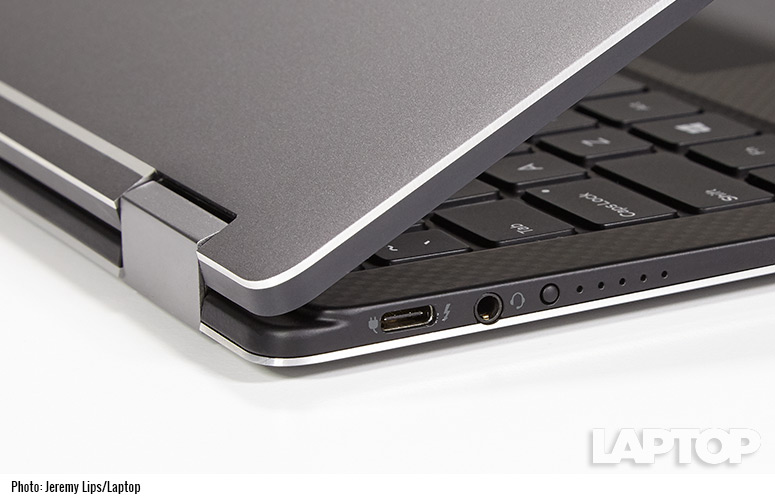
If you're willing to splurge, you can order a configuration with a Core i7 chip, 16GB of RAM, a 512GB SSD and a sharper 3200 x 1800 screen, for $1,799.
Software: Refreshingly light
Dell keeps the bloatware to a minimum on the XPS 13 2-in-1. In addition to Dell's Help and Support apps, you'll find McAfee LiveSafe for security, Dropbox and Office 2016 (you have to activate it) and Baamboo Player, a digital notebook that's good to use with the optional Active Pen.
You'll also find a handful of software titles that are managed by Windows 10. In my case, I saw Candy Crush Soda Saga and Groove Music, in addition to Microsoft's Solitaire Collection.
Bottom Line
After my everyday use with the XPS 13 2-in-1, I can say with confidence that it's a very capable 2-in-1 that I could see myself using daily. I love that this convertible's compact design takes up very little room in my lap (and bag) when I'm commuting.
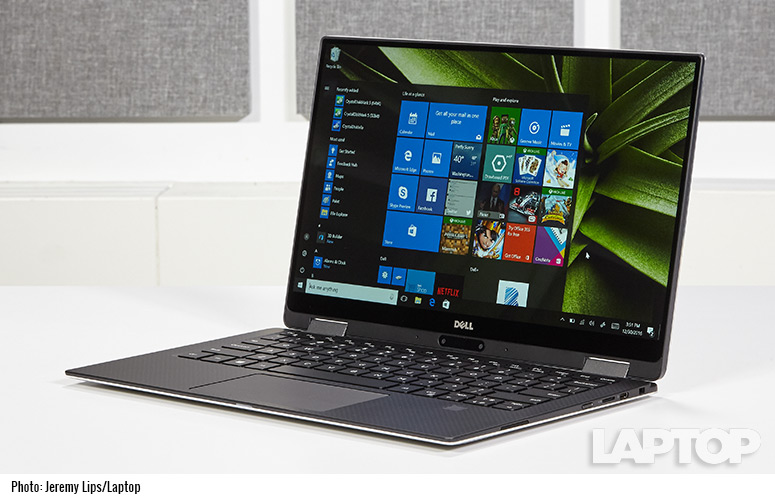
In addition, the performance from the Y Series CPU is good enough for my harried multitasking, thanks to Dell's Dynamic Power Mode. Another plus is the comfortable and fast keyboard. The practically borderless screen is bright and colorful, too, though the hues could be more accurate.
My main complaint with the XPS 13 2-in-1 is its battery life. Although 8.5 hours is above average, you can get more than 10 hours from the HP Spectre x360 and the Lenovo Yoga 910, both of which also offer more powerful U series processors but are slightly heavier. Overall, though, the XPS 13 2-in-1's combination of portability, power and comfort make it one of the best convertibles you can buy.
Dell XPS 13 2-in-1 Specs
| Bluetooth | Bluetooth 4.0 |
| Brand | Dell |
| CPU | 1.2-GHz Core i5-7Y54 |
| Card Slots | microSD |
| Company Website | http://www.dell.com |
| Display Size | 13 |
| Hard Drive Size | 256GB SSD |
| Hard Drive Speed | n/a |
| Hard Drive Type | mSATA SSD |
| Highest Available Resolution | 3200 x 1800 |
| Native Resolution | 1920x1080 |
| Operating System | Windows 10 |
| Ports (excluding USB) | USB Type-C, Thunderbolt |
| RAM | 8GB |
| RAM Upgradable to | 16GB |
| Size | 11.98 x 7.81 x 0.54 inches |
| Touchpad Size | 4.1 x 2.4 inches |
| Warranty/Support | one year limited warranty |
| Weight | 2.7 pounds |

